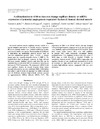Identificador persistente para citar o vincular este elemento:
https://accedacris.ulpgc.es/jspui/handle/10553/6539
| Título: | Acclimatization to 4100 m does not change capillary density or mRNA expression of potential angiogenesis regulatory factors in human skeletal muscle | Autores/as: | Lundby, Carsten Pilegaard, Henriette Andersen, Jesper L. van Hall, Gerrit Sander, M. Calbet, JAL |
Clasificación UNESCO: | 241106 Fisiología del ejercicio | Palabras clave: | Hypoxia Altitude Muscle |
Fecha de publicación: | 2004 | Publicación seriada: | Journal of Experimental Biology | Resumen: | Increased skeletal muscle capillary density would be a logical adaptive mechanism to chronic hypoxic exposure. However, animal studies have yielded conflicting results, and human studies are sparse. Neoformation of capillaries is dependent on endothelial growth factors such as vascular endothelial growth factor (VEGF), a known target gene for hypoxia inducible factor 1 (HIF-1). We hypothesised that prolonged exposure to high altitude increases muscle capillary density and that this can be explained by an enhanced HIF-1alpha expression inducing an increase in VEGF expression. We measured mRNA levels and capillary density in muscle biopsies from vastus lateralis obtained in sea level residents (SLR; N=8) before and after 2 and 8 weeks of exposure to 4100 m altitude and in Bolivian Aymara high-altitude natives exposed to approximately 4100 m altitude (HAN; N=7). The expression of HIF-1alpha or VEGF mRNA was not changed with prolonged hypoxic exposure in SLR, and both genes were similarly expressed in SLR and HAN. In SLR, whole body mass, mean muscle fibre area and capillary to muscle fibre ratio remained unchanged during acclimatization. The capillary to fibre ratio was lower in HAN than in SLR (2.4+/-0.1 vs 3.6+/-0.2; P<0.05). In conclusion, human muscle VEGF mRNA expression and capillary density are not significantly increased by 8 weeks of exposure to high altitude and are not increased in Aymara high-altitude natives compared with sea level residents. | URI: | https://accedacris.ulpgc.es/handle/10553/6539 | ISSN: | 0022-0949 | DOI: | 10.1242/jeb.01225 | Fuente: | Journal Of Experimental Biology[ISSN 0022-0949],v. 207 (22), p. 3865-3871 |
| Colección: | Artículos |
Vista completa
Citas SCOPUSTM
67
actualizado el 08-jun-2025
Citas de WEB OF SCIENCETM
Citations
58
actualizado el 08-jun-2025
Visitas
115
actualizado el 28-dic-2024
Descargas
150
actualizado el 28-dic-2024
Google ScholarTM
Verifica
Altmetric
Comparte
Exporta metadatos
Este elemento está sujeto a una licencia Licencia Creative Commons

